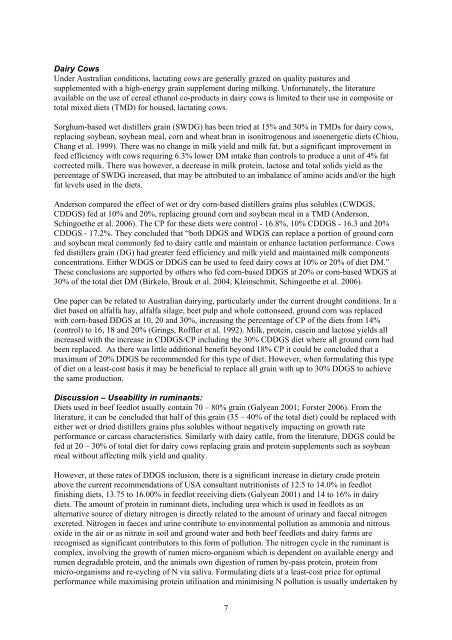Biofuel Co-Products as Livestock Feed
Biofuel Co-Products as Livestock Feed
Biofuel Co-Products as Livestock Feed
You also want an ePaper? Increase the reach of your titles
YUMPU automatically turns print PDFs into web optimized ePapers that Google loves.
Dairy <strong>Co</strong>ws<br />
Under Australian conditions, lactating cows are generally grazed on quality p<strong>as</strong>tures and<br />
supplemented with a high-energy grain supplement during milking. Unfortunately, the literature<br />
available on the use of cereal ethanol co-products in dairy cows is limited to their use in composite or<br />
total mixed diets (TMD) for housed, lactating cows.<br />
Sorghum-b<strong>as</strong>ed wet distillers grain (SWDG) h<strong>as</strong> been tried at 15% and 30% in TMDs for dairy cows,<br />
replacing soybean, soybean meal, corn and wheat bran in isonitrogenous and isoenergetic diets (Chiou,<br />
Chang et al. 1999). There w<strong>as</strong> no change in milk yield and milk fat, but a significant improvement in<br />
feed efficiency with cows requiring 6.3% lower DM intake than controls to produce a unit of 4% fat<br />
corrected milk. There w<strong>as</strong> however, a decre<strong>as</strong>e in milk protein, lactose and total solids yield <strong>as</strong> the<br />
percentage of SWDG incre<strong>as</strong>ed, that may be attributed to an imbalance of amino acids and/or the high<br />
fat levels used in the diets.<br />
Anderson compared the effect of wet or dry corn-b<strong>as</strong>ed distillers grains plus solubles (CWDGS,<br />
CDDGS) fed at 10% and 20%, replacing ground corn and soybean meal in a TMD (Anderson,<br />
Schingoethe et al. 2006). The CP for these diets were control - 16.8%, 10% CDDGS - 16.3 and 20%<br />
CDDGS - 17.2%. They concluded that “both DDGS and WDGS can replace a portion of ground corn<br />
and soybean meal commonly fed to dairy cattle and maintain or enhance lactation performance. <strong>Co</strong>ws<br />
fed distillers grain (DG) had greater feed efficiency and milk yield and maintained milk components<br />
concentrations. Either WDGS or DDGS can be used to feed dairy cows at 10% or 20% of diet DM.”<br />
These conclusions are supported by others who fed corn-b<strong>as</strong>ed DDGS at 20% or corn-b<strong>as</strong>ed WDGS at<br />
30% of the total diet DM (Birkelo, Brouk et al. 2004; Kleinschmit, Schingoethe et al. 2006).<br />
One paper can be related to Australian dairying, particularly under the current drought conditions. In a<br />
diet b<strong>as</strong>ed on alfalfa hay, alfalfa silage, beet pulp and whole cottonseed, ground corn w<strong>as</strong> replaced<br />
with corn-b<strong>as</strong>ed DDGS at 10, 20 and 30%, incre<strong>as</strong>ing the percentage of CP of the diets from 14%<br />
(control) to 16, 18 and 20% (Grings, Roffler et al. 1992). Milk, protein, c<strong>as</strong>ein and lactose yields all<br />
incre<strong>as</strong>ed with the incre<strong>as</strong>e in CDDGS/CP including the 30% CDDGS diet where all ground corn had<br />
been replaced. As there w<strong>as</strong> little additional benefit beyond 18% CP it could be concluded that a<br />
maximum of 20% DDGS be recommended for this type of diet. However, when formulating this type<br />
of diet on a le<strong>as</strong>t-cost b<strong>as</strong>is it may be beneficial to replace all grain with up to 30% DDGS to achieve<br />
the same production.<br />
Discussion – Useability in ruminants:<br />
Diets used in beef feedlot usually contain 70 – 80% grain (Galyean 2001; Forster 2006). From the<br />
literature, it can be concluded that half of this grain (35 – 40% of the total diet) could be replaced with<br />
either wet or dried distillers grains plus solubles without negatively impacting on growth rate<br />
performance or carc<strong>as</strong>s characteristics. Similarly with dairy cattle, from the literature, DDGS could be<br />
fed at 20 – 30% of total diet for dairy cows replacing grain and protein supplements such <strong>as</strong> soybean<br />
meal without affecting milk yield and quality.<br />
However, at these rates of DDGS inclusion, there is a significant incre<strong>as</strong>e in dietary crude protein<br />
above the current recommendations of USA consultant nutritionists of 12.5 to 14.0% in feedlot<br />
finishing diets, 13.75 to 16.00% in feedlot receiving diets (Galyean 2001) and 14 to 16% in dairy<br />
diets. The amount of protein in ruminant diets, including urea which is used in feedlots <strong>as</strong> an<br />
alternative source of dietary nitrogen is directly related to the amount of urinary and faecal nitrogen<br />
excreted. Nitrogen in faeces and urine contribute to environmental pollution <strong>as</strong> ammonia and nitrous<br />
oxide in the air or <strong>as</strong> nitrate in soil and ground water and both beef feedlots and dairy farms are<br />
recognised <strong>as</strong> significant contributors to this form of pollution. The nitrogen cycle in the ruminant is<br />
complex, involving the growth of rumen micro-organism which is dependent on available energy and<br />
rumen degradable protein, and the animals own digestion of rumen by-p<strong>as</strong>s protein, protein from<br />
micro-organisms and re-cycling of N via saliva. Formulating diets at a le<strong>as</strong>t-cost price for optimal<br />
performance while maximising protein utilisation and minimising N pollution is usually undertaken by<br />
7

















